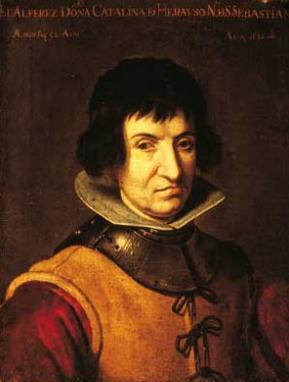thestuartkings: Catalina de Erauso, also known in Spanish as La Monja Alférez&
thestuartkings:Catalina de Erauso, also known in Spanish as La Monja Alférez (English, The Nun Lieutenant) (1592 —1650), was a semi-legendary personality of the Basque Country, Spain and Spanish America in the first half of the 17th century.Catalina de Erauso was daughter and sister of soldiers from the city of San Sebastián in Spain. Her father was Miguel de Erauso and her mother María Pérez de Gallárraga y Arce. She was expected to become a nun but abandoned the nunnery after a beating at the age of fifteen, just before she was to take her vows. She had not ever seen a street, having entered the convent at the age of four .She dressed as a man, calling herself “Francisco de Loyola”, and left on a long journey from San Sebastian to Valladolid. From there she visited Bilbao, where she signed up on a ship with the assistance of other Basques. She reached Spanish America and enlisted as a soldier in Chile under the name Alonso Díaz Ramírez de Guzmán. She served under several captains in the Arauco War, supposedly including her own brother, who never recognized her.After one fight in which she killed a man and was wounded apparently fatally, she revealed her sex in a deathbed confession. She however survived after four months of convalescence and left for Guamanga.To escape yet another incident, she confessed her sex to the bishop, Fray Agustín de Carvajal. Induced by him she entered a convent and her story spread across the ocean. In 1620, the archbishop of Lima called her. In 1624, she arrived in Spain, having changed ship after another fight.She went to Rome and toured Italy, where she eventually achieved such a level of fame that she was granted a special dispensation by Pope Urban VIII to wear men’s clothing.She again left Spain in 1645, this time for New Spain in the fleet of Pedro de Ursua, where she became a mule driver on the road from Veracruz. In New Spain she used the name Antonio de Erauso.She died in Cuetlaxtla, New Spain in 1650.Pedro del Valle described her in a 1626 letter sent from Rome to Mario Schipano as: “fond of conversation, tall and strong with masculine looks and childlike breasts. Her face is not ugly but worn by age, looking more like a eunuch than a woman. She dressed as a Spanish man, with a sword, more as a soldier than a courtier”. -- source link

